
| Mitsubishi Lancer Is Back to Rallies - '81 |
|
| Mitsubishi Motors Corporation (MMC), off the international rallying scene for some 3 years since that overwhelming victory in the 1977 Bandama event, has decided to participate into the 1981 WCR rallies with its newly developed high-performance Lancer 2000 Rally Turbo. (Obvious precessor to the Starion & EVO Lancers!) |
The entry machines are the tuned-up version of Lancer 2000 Turbo which has already been put on market in West Germany,Belgium, Holland, Switzerland, Austria, UK and France since April 1st, 1981, with a very high evaluation as the worlds fastest 2-litre sedan.
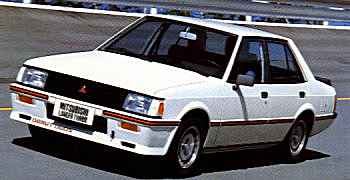
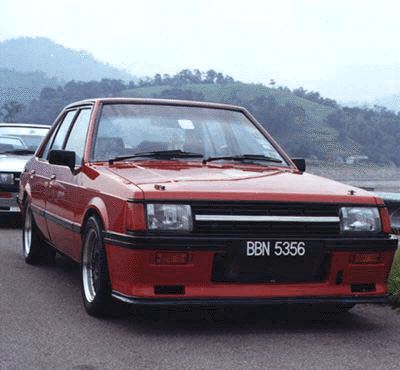
The high-speed, high-performance touring car Lancer 2000 Turbo is engineered to meet the fast-growing needs of the world's market where economical, performance cars are seriously wanted while the mainstream of design tends to be simply smaller, and more and more economical. At the same time, the 2000 Turbo is expected as an image leader in the KG markets for MMC's products.
The new turbocharged Lancer fully utilizes the light, highly rigid non-turbo Lancer body boasting a perfect match between its brawny turbocharged power plant and ingenious heavy-duty suspension resulting in very high performance and stability. Worthy of being called the fastest sedan in the world.
The entries in the WCR events are decided to prove the ultimate performance potential of the master-engineered Lancer Turbo and its tuned-up engine that produces some 2ttPS(DIN) out of the compact, cylinder configuration. In other words, that is the opportunity to prove MMC~s high technological standards behind the pursuit of maximum performance in a compact, 2-litre sedan, challenging the international apex of automotive engineering.
In another aspect, the entries of sheer Japanese turbocharged cars have been gathering wide and keen attentions of the international rally circle as the year 1981 is regarded the combats between Turbo’s" especially in the "sprint WCR events in which Audi Quattro and Renault 5 have already won an event respectively.
The entries of Lancer Rally Turbo are to be made under the Team Ralliart which will be the core of motor sports activities of MMC.
Rallies for Mitsubishi -- A Brief History
MMC has entered quite a few international and domestic rallies with its mass~production-model based rally cars. It has been, and will be, indispensable to further improve technology and engineering standards incorporating the data gained through fierce, torturing conditions in which the pure comparison with competition could be made. The only way to eliminate the weak points, and to develop superiority.
The results are beautifully materialized in the Galant and Lancer. perfectly balanced performance and handling, efficiency and reliability with outstanding safety behind the high international recognition are nothing but the accumulated technological experience gained through the numerous rally activities.
Team Organization
MMC and its Austria Distributor Denzel AG have jointly developed the Lancer 2000 Rally Turbo. participation’s will be made by the rally team (Team Ralliart as the entrant) organized by Denzel who produce and serve the rally cars. The distributors in rally locales will also be responsible for ill-round supports. The beginning entry in Acropolis will have Andrew Cowan and Anders Kullang behind the wheels.
About the Lancer 2000 Turbo Group 4 Rally Car
In the past decade Lancer has established impressive records of success in international rallies. The rally car is the latest in a long Lancer line of thoroughbred competition vehicles developed by MMC. Basically same as the regular production Lancer 2000 Turbo, the Group 4 rally car is engineered to meet and exceed extraordinary demands of the international stage rally such as the Acropolis Rally.
Under-body protection is increased by the addition of light-weight alloy shield which covers the underside of the engine and gearbox. The single overhead camshaft 2OOOcc, 8-valve, cylinder unit with the addition of newly developed electronic control injection plus a competition turbocharger with intercooler produces 280PS at 7,Oltrpm (GIN), quite an increase over the base power plant with l7PS at ? rpm(DIN).
The TIM gear ratios are changed and a limited slip differential is incorporated in the rear axle. In order to produce high rates of acceleration with a comparatively low maximum speed the ratio of the final drive unit is also changed.
This year no less than 12 different types of Yokohama tyres ranging from extra wide, hand-cut racing tyres to narrow deep mud tyres will be available to the drivers in the rally team, The light weight alloy, extra wide wheels are enclosed within special wheelarch extensions and both the front and rear suspension systems incorporate gas/oil filled shock absorber units,
In order to provide maximum protection for the occupants of the Lancer Rally Turbo, a special steel safety cage is built into the car. Full aircraft type seat harnesses are provided for both driver and navigator, a special fireproof bulkhead is built across the rear of the car between the boot and the passenger compartment and the long-range fuel tank which is mounted in the boot filled with plastic foam to prevent fuel spillage in the event of the tank rupture.
The ignition can be switched off from either inside or outside the car, and a special fire extinguishing system is fitted.The normal production Lancer 2000 Turbo is equipped with halogen headlamps and, as the Acropolis Rally event has many stages in darkness, four additional halogen lamps are fitted to each rally car,
International rallies form a particularly important part of manufacturers' engineering development programs. The many improvements which have been brought about in suspension, brakes, lights, comfort and durability in today's production cars have been developed in competition.
Lancer 1400 ,1600 cc
& Sirius Engine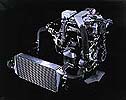
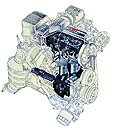
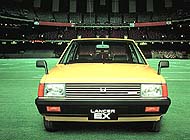
In 1979, the Lancer underwent its first major model change with the release of the Lancer EX. The Lancer EX offered a choice of two award winning engines: the 1400cc, MCA-JET equipped Orion engine or the 1600cc Saturn 80 engine, both integrating Mitsubishi's Silent Shaft technology. This second generation Lancer was developed for the post oil crises era and incorporated many class leading features to upgrade motoring enjoyment. Its new styling was simpler, adopting what was called a "boxy look" design. The interior was brighter and more spacious and adopted a new high performance heating/ventilation system to improve interior comfort. For the family on the go, the Lancer EX offered a larger, deeper trunk space to provide added convenience. A strong lightweight body adopting a 4-link rear suspension upgraded handling as well as assuring a smooth, quiet ride. The 1800cc, Sirius 80 engine was introduced in 1980, followed by a new 1200cc engine in 1981 providing for a wider choice of engine application to the Lancer lineup. For even sportier performance, a turbocharged, 1800cc engine was added in 1980 and in 1983 an integrated intercooler system to provide 165ps.
In the 80s as fuel shortages of the 70s
became just a memory, demand for higher performance cars became evident. Mitsubishi's
answer to this new demand was turbocharging and in 1982 the Starion was introduced to the
market. The Starion was developed incorporating the latest engineeing technology bringing
together high speed utilization with fuel economy. Mitsubishi Motors as a pioneering force
in the field of aerodynamics since the 50s incorporated the latest in aerodynamic design
technology in the creation of Starion's sleek exterior body styling.
The Starion's new approach to aerodynamics
dramatically improved road holding abilities at high speeds, assured sure footed handling,
as well as providing fuel consumption efficiency by reducing the air drag. The 145ps, Sirius 2000 ECI Turbo engine moved the Starion up the speed
curve smooth and effortlessly. The Starion had a top speed of 180km/h and would accelerate
from 0 to 400 meters in 16.1 seconds. In 1983, an intercooler was integrated into
the enigine boosting its power performance to 175ps.
The revolutionary new
Sirius-Dash 3x2 valve engine was introduced in 1984 boosting the power performance yet
further to 200ps. Four wheel ventilated disc brakes with ABS provided the Starion
with the ability to rein in speed with sure control. All in all, Mitsubishi's advanced
technology gave the Starion characteristics expected in much more expensive sport coupes.
Like its highly successful predecessors bearing the three diamond marque, the Starion made
its presence known in the world of motorsports. Its durability, reliability and high
performance were proven again and again with many major victories in the most prestigious
national race and rally championships the world over during the early and mid 80s.

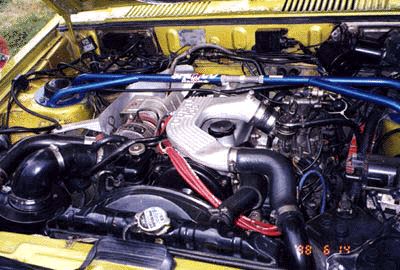
The Lancer 2000 Turbo Specification
* Engine: Type: 4G62B
Displacement: 1997cc
Bore x Stroke(mm): 85.0 x 88.0
Max Output(DIN): 175 ++ PS/7,tOOrpm
Max Torque(DIN): 33.7kg-m/5,OO rpm
Fuel Supply: Electronic Control Injection (Independent)
Turbocharger: Competition Turbocharger with Intercooler
* Gearbox(Five Forward synchronized)
1st 2.85
2nd 2.11
3rd 1.58
4th 1.23
5th 1.00
Rear Axle Ratio: 4.625 (with LSD) [Limited Slip Diffrent ]
* Brakes
Front and Rear Ventilated Discs
* Suspension
With Heavy-Duty Springs and Shock Absorbers
* Steering
Close Ratio Recirculating Ball (3 bearing cross-shaft)